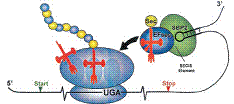Biochemistry, Department of

Vadim Gladyshev Publications
Document Type
Article
Date of this Version
May 2006
Abstract
Dietary selenium has potent cancer prevention activity. Both low molecular weight selenocompounds and selenoproteins are implicated in this effect. Thioredoxin reductase 1 (TR1) is one of the major antioxidant and redox regulators in mammals that supports p53 function and other tumor suppressor activities. However, this selenium-containing oxidoreductase is also overexpressed in many malignant cells and has been proposed as a target for cancer therapy. To further assess the role of TR1 in the malignancy process, we used RNA interference technology to decrease its expression in mouse lung carcinoma (LLC1) cells. Stable transfection of LLC1 cells with a small interfering RNA construct that specifically targets TR1 removal manifested a reversal in the morphology and anchorage-independent growth properties of these cancer cells that made them similar to those of normal cells. The expression of at least two cancer-related protein mRNAs, Hgf and Opn1, were reduced dramatically in the TR1 knockdown cells. Mice injected with the TR1 knockdown showed a dramatic reduction in tumor progression and metastasis compared with those mice injected with the corresponding control vector. In addition, tumors that arose from injected TR1 knockdown cells lost the targeting construct, suggesting that TR1 is essential for tumor growth in mice. These observations provide direct evidence that the reduction of TR1 levels in malignant cells is antitumorigenic and suggest that the enzyme is a prime target for cancer therapy.


Comments
Published in THE JOURNAL OF BIOLOGICAL CHEMISTRY, VOL. 281, NO. 19, pp. 13005–13008, May 12, 2006.